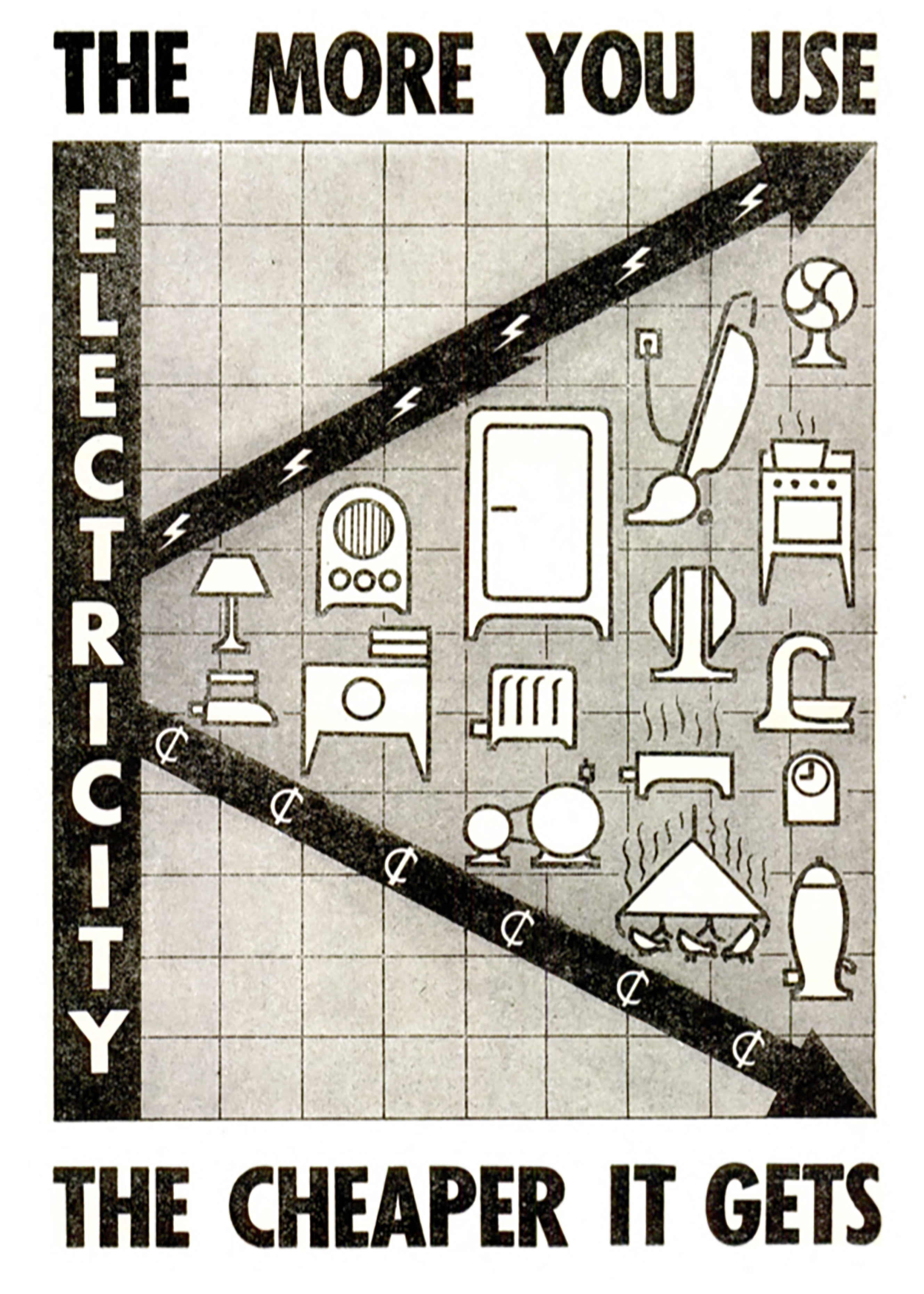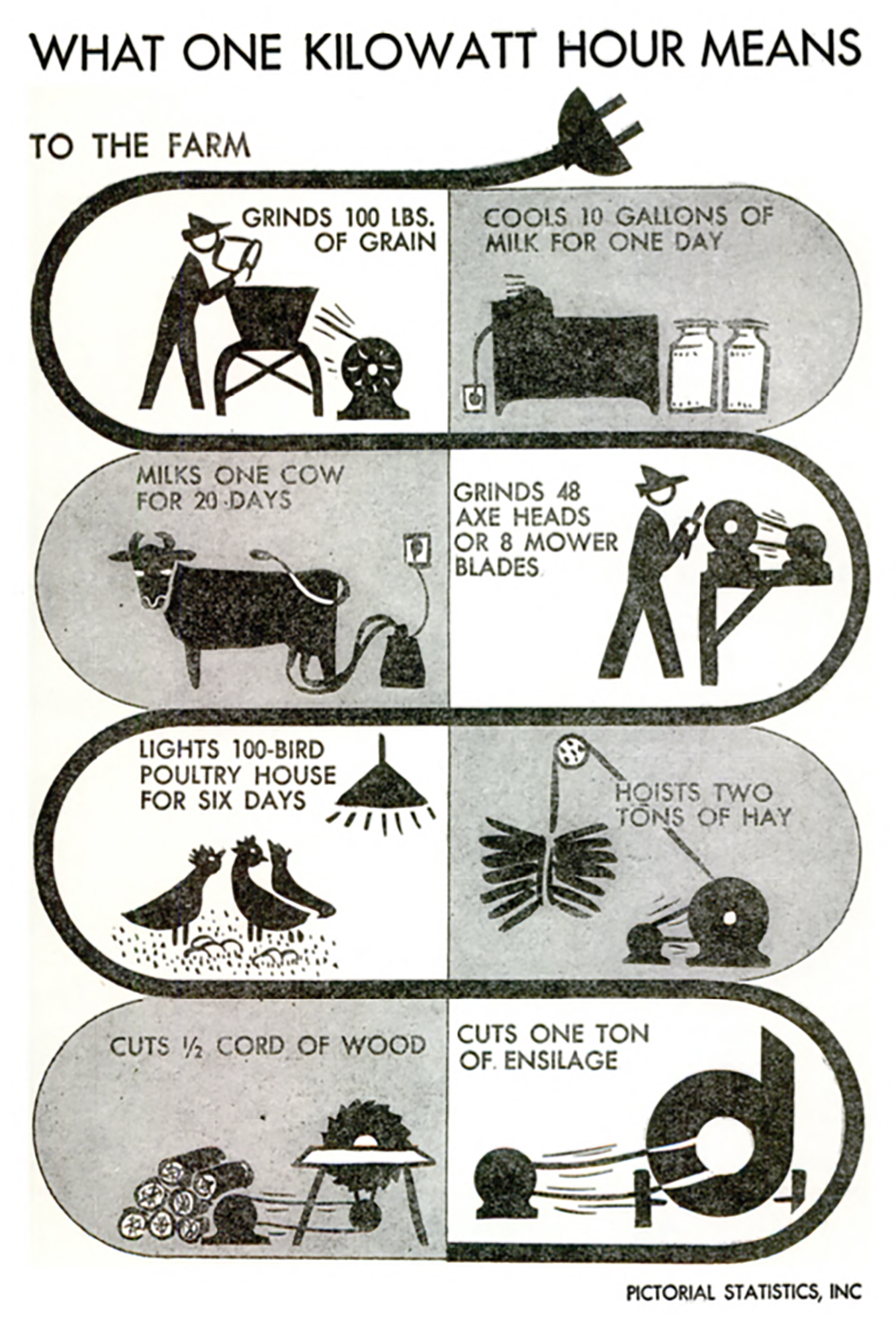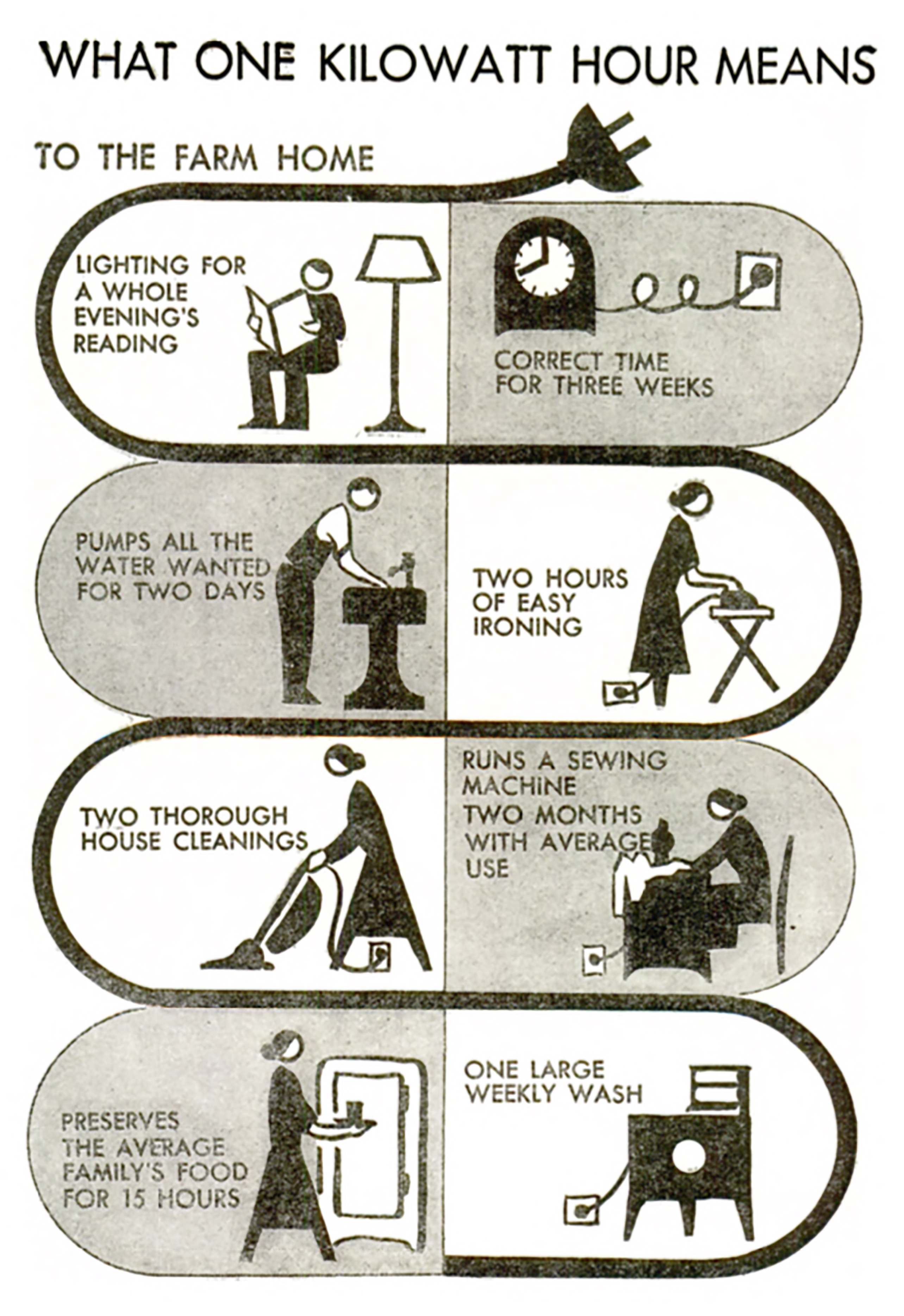
Meet Mr. Kilowatt: Building Demand for Electricity in the Rural U.S., 1936-1940
Technology’s Stories vol. 5, no. 3 – doi:10.15763/jou.ts.2017.08.27.03
Take U.S. Highway 377 South from Ft. Worth, drive across the Brazos River, through Tolar and Bluff Dale, and past Stephenville. By the time you pass the field of rusting farm equipment near Proctor, you’ll be in Comanche County, Texas. The first white settlers put down roots here during the 1850s, naming the county (and later its seat) after its most recent native residents. During the late nineteenth century, ranchers and railroad workers moved in, and eventually, towns like Comanche, De Leon, and Gustine became part of the Populist Movement’s burned-over district. The county never outgrew those rural origins. Even during the 1910s and 20s, the early years of the Texas oil boom, population stayed below twenty-five thousand, and by 1939, only somewhere between eighteen and nineteen thousand people called Comanche County home. So it was a rare occasion when a newcomer came to the county. It was even rarer for one to introduce themselves in the local newspaper, but Mr. Kilowatt was different. Having recently moved “out to the country to work,” he wanted to make sure his new neighbors knew he had arrived. “Hello, Boss,” he wrote in the December 1, 1939 edition of The Comanche Chief. “I am the new handy man.”[1]
According to the bulletin that appeared alongside that introduction, locals interested in hiring a farm hand “so full of energy” that he never slept could “Meet Mr. Kilowatt” at the traveling farm equipment show that would stop at T.J. Williams’s farm December 7-8.[2] While there, visitors could also watch demonstrations of electricity’s practical uses, meet representatives from the local electricity cooperative, and hear officials from the federal Rural Electrification Administration talk about financing options for home wiring and electrical equipment. After the two-day event, the paper promised, Comanche County farmers would see how easy it was to make electricity “pay its way” by “putting it to work.”[3]
A growing number of farmers put electricity to work during the 1930s. At the outset of the Great Depression, only 10 percent of farms—compared to 90 percent of urban homes—had electricity. The Roosevelt Administration saw balancing that inequality as integral to its efforts to spur economic development and modernize rural America, and embarked upon a massive rural electrification venture. In 1933, Congress chartered the Tennessee Valley Authority (TVA), a federally owned corporation tasked with flood control, electricity generation, and economic development in seven southeastern states. Three years later, lawmakers extended rural electrification by passing the Rural Electrification Act of 1936. Roosevelt had created the Rural Electrification Administration (REA) the year before through an executive order authorizing it to administer low-interest loans for the construction of transmission lines by local electricity cooperatives across the country. With the 1936 act, Congress made the REA a permanent institution that could continue to pursue that already successful strategy. By 1940, the agency had issued more than $277 million in loans to as many as 600 cooperatives in 44 states. Just as impressively, the number of farms with electricity doubled during those years.[4]
That success seems obvious in retrospect (who wouldn’t want electricity?), but historians know that access to a new technology does not guarantee its adoption.[5] The REA not only had to convince farmers that they needed electricity, but also recognized the need to encourage purchases of the new technology it enabled. This essay sketches the contours of those efforts, which officials referred to as “utilization” or “load building” programs, to explain how the REA spurred demand for electricity at the same time that it expanded access to it. In the process, it provides additional support for the conclusion that energy transitions—periods of changes to the fuels or technologies a society uses to produce energy—often depend on aggressive entrepreneurial efforts to create demand.[6] Thus the story of the REA’s load building programs also shows how technology facilitated the spread of a new political economy that revolved around mass consumption.[7]
Affordability was the core concept in the REA’s utilization program. Lawmakers created the agency under the assumption that private utilities were reluctant to install new lines in rural areas because demand there was too low to warrant the cost. Farms functioned both as homes and sites of production, so they were an exception to that rule. Experts such as the President of the New York Edison Company, Matthew Scott Sloan, believed that farmers’ “many uses for current” might someday make them “valuable customers,” and yet they worried that there would always be some farms “so situated geographically and so conditioned economically that they will not be able to afford electricity.”[8]
The REA’s load building strategy addressed affordability in two ways. First, the agency published literature that taught farmers the various applications of electricity. Through text and illustrations, the agency highlighted some of the two hundred uses for electricity it had identified, and explained that the high fixed costs of power generation meant that higher utilization resulted in lower per-kilowatt costs.[9]
 The agency argued that farmers could afford electricity, but only if they used it in as many ways as possible. Second, the agency encouraged farmers to consider electrification as a business investment by publicizing studies of electricity’s impact on agricultural productivity, such as the American Society of Agricultural Engineers report that found that farmers with electric light spent 1.9 fewer hours a day on indoor chores than those with gas lights.[10] It also filled pages of promotional literature with suggested applications that would make farms more efficient, including electric milking machines, feed grinders, and hotbeds for growing out-of-season crops.[11]
The agency argued that farmers could afford electricity, but only if they used it in as many ways as possible. Second, the agency encouraged farmers to consider electrification as a business investment by publicizing studies of electricity’s impact on agricultural productivity, such as the American Society of Agricultural Engineers report that found that farmers with electric light spent 1.9 fewer hours a day on indoor chores than those with gas lights.[10] It also filled pages of promotional literature with suggested applications that would make farms more efficient, including electric milking machines, feed grinders, and hotbeds for growing out-of-season crops.[11]
 By powering their factories with electricity, other businesses had made efficiency a tenet of modern industrial production. Rural electrification offered farmers the opportunity to do the same for agriculture. Simply put, the REA’s booklets advised that “the best way to start planning about the use of electricity,” was not to “waste much time on mental pictures of electric toasters and electrically heated shaving water.” Rather, farmers should “begin with the practical everyday jobs around the house and barn,” where electrical equipment could save them time and money.[12]
By powering their factories with electricity, other businesses had made efficiency a tenet of modern industrial production. Rural electrification offered farmers the opportunity to do the same for agriculture. Simply put, the REA’s booklets advised that “the best way to start planning about the use of electricity,” was not to “waste much time on mental pictures of electric toasters and electrically heated shaving water.” Rather, farmers should “begin with the practical everyday jobs around the house and barn,” where electrical equipment could save them time and money.[12]
But the REA’s promotional efforts went beyond questions of cost and affordability. They also depicted electric equipment as essential to modern life. Electricity helped clocks run on time, connected rural families to the broader world through radio, and made food storage simpler. Running water, pumped by electric motors, helped suppress fires, increased sanitation (which could also save farm families on health care costs), and was, in general, an indication of “modern living.”[13] Fans cooled homes in the summer, making “farm life pleasenter,” (sic) and electric lights meant “no more smoky, smelly lamps for the modern farm.”[14] These modern conveniences were particularly useful in domestic life, which REA literature stressed as an equally important—though starkly gendered—area of application. Electric ranges made “good cooks even better,” the agency reported, and “busy farm women” who cooked for large groups of people found “the electric mixer a great joy and time saver.”[15] Electricity also lightened the drudgery of other tasks that REA literature assumed would be performed by women. In the words of one booklet, by using electricity to eliminate the “steaming heat of the kitchen, the dragging labor of lugging water from the well and wood from the shed,” and the eye strain created by washing dishes at night, “the farmer’s wife, as well as the farmer, can appreciate the conveniences that electricity will bring to the farm.”[16]

Alongside these obvious assumptions about the division of labor, gender also played a major role in how the REA approached its goal of transforming farm families into consumers. Farmers had always been paragons of a masculine Jeffersonian ideal, both in their own minds and in the broader cultural imagination.[17] They produced more than they consumed, owned their own land, and held true to values of hard work and independence. Electrification seemed to require modifications to that template, particularly in the balance between production and consumption. So the REA emphasized farmers’ self-sufficiency in its reports and literature, which featured stories about inventive tinkerers who developed “many home-made, interesting, and practical electrical devices.”[18] One Iowa farmer cobbled scrap lumber, galvanized tin, a large light bulb, and some canvas into an electric chicken brooder. Another “nailed together a few boards,” added a 100-watt lamp and reflector, and created an electric pig brooder that significantly increased the survival rate of his sow’s litters.[19] By supplementing its assertions of electricity’s potential economic benefits with stories like these, the REA could assuage any anxiety over the erosion of self-sufficiency felt by farmers or policymakers.
But the agency also realized that a strategy that relied on promotional literature was too indirect. So the REA adopted new tactics that it hoped would, in the words of one administrator, “move the consumers” more directly.[20] Much like the utility companies that were reluctant to service rural areas, consumer lenders often refused to extend credit to rural borrowers. Congress had addressed that issue in 1934 by establishing the Electric Home and Farm Authority (EHFA). Housed within the TVA, the EHFA financed home wiring and the purchase of electrical appliances in the TVA’s service area, offering consumers who could not afford to pay cash the opportunity to purchase electric equipment on credit at cheaper rates and on longer terms than private lenders offered. The EHFA also helped reduce the cost of appliances by forcing redesigns of models eligible for the program.[21] The REA extended EHFA financing beyond the Tennessee Valley in 1937, making it a key part of its load building program. The agency also organized field units, each of which consisted of three members: a utilization representative, a home electrification specialist, and an agricultural engineer.[22] These agents operated like traveling salespeople, setting out from regional offices to make the rounds at nearby farms, where they demonstrated home appliances and equipment that had been developed by the REA specifically for farm use.[23]
The farm equipment show that brought Mr. Kilowatt to Central Texas in late 1939 executed the REA’s strategies on a much larger scale. Starting in New England, the show traversed the country like a tent revival. At each stop, REA agents, state extension officers, local cooperatives, and appliance manufacturers set up exhibit tents and trailers on fairgrounds or farms. Newspapers advanced the REA’s strategy of promoting demand on the farm and in the home by advertising the show as an occasion for the entire family. The men were expected to visit exhibits demonstrating new technologies such as automatic water pressure systems, milkers, coolers, and a 10-horsepower electric motor. “The women, in the meantime,” could “study kitchen planning, electric cookery with the range and with small appliances, a laundry demonstration, discussion of the farm refrigerator and points on the care and selection of household appliances.”[24] According to REA reports, more than 400,000 people had attended the show by the end of 1940.[25] Mr. Kilowatt, it seemed, would soon have all the work he could handle.
Rural electrification was the final stage of the most significant energy transition of the twentieth century. During the late nineteenth and early twentieth centuries, electricity was a luxury that few could afford. But by the middle of the twentieth century, it had become such a staple that few could imagine life without it. The impacts were pervasive. Electricity severed the final tendons coupling work to the rhythm of the sun, made settlement in formerly inhospitable climates more appealing, and sent economic productivity skyrocketing. Simply put, the world we live in today is a world that was built with electricity.[26] The story of the REA’s load building efforts shows how that is true in more ways than one. By convincing American farmers to adopted electricity and the various technologies it enabled, the REA helped blur the boundaries between urban and rural life and folded American farmers into a new culture of consumerism in the process.
Jonathon Free is a Post-Doctoral Associate at the Duke University Energy Initiative. His research examines the relationships between energy and changing patterns of work, business, and policy in the twentieth-century U.S.
Suggested Readings:
David E. Nye, Electrifying America: Social Meanings of a New Technology, 1880-1940
Ronald C. Tobey, Technology as Freedom: The New Deal and the Electrical Modernization of the American Home
Christopher F. Jones, Routes of Power: Energy and Modern America
Gretchen Bakke, The Grid: The Fraying Wires Between Americans and Our Energy Future
Ronald R. Kline, Consumers in the Country: Technology and Social Change in Rural America
Carolyn M. Goldstein, Creating Consumers: Home Economists in Twentieth-Century America
[1] “Meet Mr. Kilowatt, the New Farm Hand,” The Comanche Chief (Comanche, TX), December 1, 1939, pg. 9.
[2] The article’s authorship is unclear, but whoever wrote it did a fine job of personifying the power and versatility of electricity. “I have never been fired from a job in my life,” they wrote, “I have turned motors and baked cakes. I have controlled the signal systems for the railroads and I have run toy trains for children. I am not conceited when I say there is just about nothing I can’t do if I have the proper equipment. And, Boss, I am so full of energy that I never sleep. I never take time out to eat,” “Meet Mr. Kilowatt.”
[3] “To Members and Friends of the Comanche, Hamilton, & Erath Cooperatives, REA,” The Comanche Chief,December 1, 1939,9.
[4] On the process and impact of rural electrification, see David E. Nye, Electrifying America: Social Meanings of a New Technology, 1880-1940, (Cambridge, Mass.: The MIT Press, 1992); Ronald C. Tobey, Technology as Freedom: The New Deal and the Electrical Modernization of the American Home (Berkeley: University of California Press, 1996); Leah S. Glaser, Electrifying the Rural American West: Stories of Power, People, and Place (Lincoln: University of Nebraska Press, 2009).
[5] That is also true today, as scholars, government agencies, and NGOs striving to expand energy access in developing countries can attest. For an overview of those efforts and their relationship to the U.S. experience, see Lorenzo Pellegrini and Luca Tasciotti, “Rural Electrification Now and Then: Comparing Contemporary Challenges in Developing Countries to the USA’s Experience in Retrospect,” Forum for Development Studies 40:1 (March 2013): 153-176.
[6] See specifically Christopher Jones’s assertion that, in the case of the fossil fuel revolution, “to create an energy transition, entrepreneurs had to work aggressively to build demand.” Christopher F. Jones, Routes of Power: Energy and Modern America (Cambridge: Harvard University Press, 2016), 5.
[7] Other work that addresses this topic includes Ronald R. Kline, Consumers in the Country: Technology and Social Change in Rural America (Baltimore: Johns Hopkins University Press, 2002); Carolyn M. Goldstein, Creating Consumers: Home Economists in Twentieth-Century America (Chapel Hill: The University of North Carolina Press, 2014).
[8] M.S. Sloan, “Electricity–Mankind’s Universal Servant,” The Annals of the American Academy of Political and Social Science 159 (January 1932): 143.
[9] U.S. Department of Agriculture, Rural Electrification Administration, A Guide for Members of Cooperatives (Washington, D.C.: Government Printing Office, 1939), 38.
[10] U.S. Department of Agriculture, Rural Electrification Administration, Profits from Farm Power (Washington, D.C.: Government Printing Office, 1940), 7.
[11] Illustrations and descriptions of these uses appear throughout A Guide for Members of Cooperatives.
[12] U.S. Rural Electrification Administration, Electric Power on the Farm, edited by David Cushman Coyle (Washington, D.C.: Government Printing Office, 1936), 38.
[13] “Rural Electric Show Planned July 31-Aug 1,” Circleville Herald (Circleville, Ohio) July 22, 1939, pg 6; U.S. Rural Electrification Administration, “Report of the Administrator,”(1940), 3
[14] A Guide for Members of Cooperatives, 18, 22, 40.
[15] Ibid., 24.
[16] Electric Power on the Farm, 37.
[17] On concerns about electricity’s impact on morality, see Nye, Electrifying America, 289-291
[18] “Report of the Administrator,” 3.
[19] Profits from Farm Power, 46.
[20] U.S. Rural Electrification Administration, Rural Electrification on the March (Washington, D.C.: Government Printing Office, 1938) 58.
[21] In one example, the EHFA claimed to have halved the cost of one Westinghouse electric range by forcing the company to “cut off a lot of the fancy parts.” U.S. Congress, House of Representatives, Committee on Banking and Currency. Electric Home and Farm Authority: Hearings Before the Committee on Banking and Currency, 74th Congress, Second Session, 1936, 3.
[22] Rural Electricity on the March, 59.
[23] Reports indicated that the program was successful. After only a year, one area reported that 84 percent of farm customers owned electric irons and radios, 63 percent owned washing machines, and 35 percent toasters. “Report of the Administrator;” Rural Electricity on the March, 63.
[24] “REA Farm Equipment Show at Irvin Frost’s,” The Terril Record (Terril, Iowa) August 8, 1940, pg 1.
[25] “Report of the Administrator,” 17
[26] As the cultural anthropologist Gretchen Bakke recently pointed out, modern America “does not run on gas, oil, or coal;” it “runs on electricity.”[26] Gretchen Bakke, The Grid: The Fraying Wires Between Americans and Our Energy Future (New York: Bloomsbury, 2016), xi.
